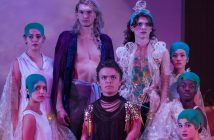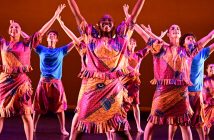A tradition of inwardly focused scholarship on the Virgin Mary has of late been brought out to include a larger, more public realm, said a medieval scholar on Nov. 27.
Miri Rubin, Ph.D., head of the School of History at Queen Mary University of London, delivered The St. Robert Southwell, S.J. Lecture, “Europe’s Mother: The Virgin Mary in the Public Sphere” at the Lincoln Center campus.
Rubin noted that scholars, once focused on the personal religious experience, are now concentrating on public religious experience, shifting the concentration on religious institutions toward a focus on religious cultures at large. Concepts like personality and emotions are now being explored, which, in turn, have made a big impact on the studies of the Virgin Mary.
“The turn to culture is a turn to meaning and experience,” said Rubin. “It aims to understand the significance of ideas and institutions for people’s lives in the past.”
Rubin described the shift as a “sea change” and said that, as a matter of course, Mary becomes central as she was often seen as “a rallying point.”
It’s a change that Rubin supports, though she acknowledged that studying lives of intimate devotion should by no means be abandoned.
But studying the Marian experience in the public domain, she said, helps produce an overarching understanding of civic life—particularly in a period when the parish sat at its center.
Rubin said much of the worship of Mary spontaneously emerged from the public, though its roots were in the domestic realm. Children learned about Mary at home and then later encountered her during feast days at church.
The most popular genre of Mary lore was of the stories of Mary’s interventions, which were developed in Latin in England in the12th century, and were soon tranlated into the local vernacular.
Mary literaly hit the streets through social groups, like fraternities, that allowed for personal and public participation through processions, chanting, and performances.
Rubin showed 13th-century Siena to have been a place where Marianism made significant inroads as “a theme for republican urban living.” The Italian city invested tremendous amounts of capital in Mary imagery.
Rubin showed slides of several Siena’s civic treasures, including the Maesta fresco by Simone Martini, in which she noted the “exquisite crafts” in the piece, from the gold leaf, to the rare lapis lazuli blues, and even Mary’s brooch, which was cast in real glass.

Rubin said that Siena’s leadership made governing decisions under the gaze of the Maesta. The social order, which Rubin described as “hierarchical but cooperative,” could be found in the piece, with Mary at its center.
Eventually statues of Mary found their way to street corners throughout Italy, where it was believed that statue’s presence was powerful enough to deter crime.
Grassroots Marian activism also made headway. Rubin cited the example of shepherd Hand Behem in 15th Century Germany, whose vision of Mary compelled him to organize a mass pilgrimage to Niklashausen. Inspired by the lowly shepherd, thousands descended onto the little town, where the pilgrimage took on political overtones through songs and chants. The local bishop responded by having Beham arresgted and dispersing the crowds.
“There was clearly some limit to Mary’s power to protect her charges on earth,” said Rubin.
The Southwell Lecture, delivered once a semester, focuses on the scholarship of the Reformation and Counter-Reformation in Europe and the Americas.


